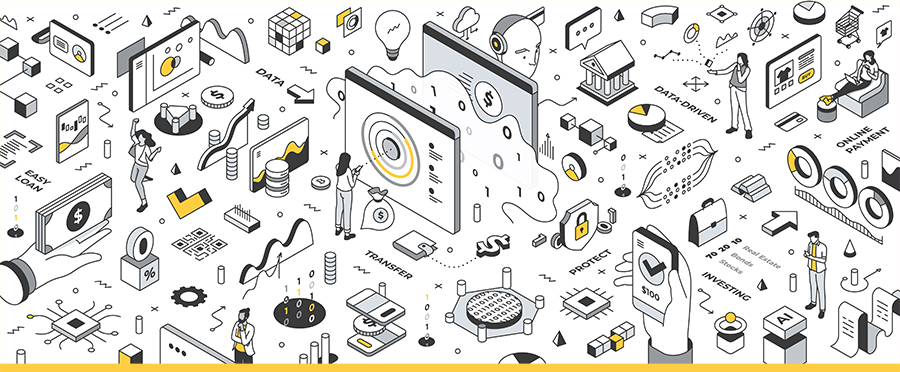Artificial intelligence has the potential to reshape banking
Today, artificial intelligence is at our fingertips, but its true impact is still taking shape. A Wells Fargo investment banker says AI has the potential to further transform financial services.
Editor’s note: This is the third and final part of a Wells Fargo Stories series focused on artificial intelligence. Read part 1: “Wells Fargo, artificial intelligence, and you.” Read part 2: “How Wells Fargo builds responsible artificial intelligence.”

Believe it or not, “artificial intelligence” was first coined nearly seven decades ago.
While the concept of AI isn’t new, popular imagination of what it means is expanding with today’s AI landscape. We’re seeing the start of new AI technology companies — for example, producers of large generative AI models — at the same time established companies further invest in AI, Wells Fargo included.
“In this next wave of AI, you’ll probably see a lot of new technologies get funded and established strategic players acquire early-stage companies at the same time,” said Jeff Spurlock, a managing director in Wells Fargo’s Corporate & Investment Bank who focuses on the fintech sector. “The financial services sector has the potential to experience a leapfrog effect from AI that’s greater than what other industries will experience, in my view.”
Banking is especially primed to see this AI activity. Case in point: Nine in 10 financial services companies are hoping to drive critical business outcomes by investing in AI, according to a 2022 NVIDIA report. Spurlock said financial services has yet to go through a true digital transformation like other industries.
“Banking today is still very much a human-to-human, relationship-driven process,” he said. “AI will enable banks to better anticipate issues and deliver more highly curated experiences.”
Wells Fargo’s tech experts are building trust and responsibility into AI in four ways: eliminating bias, providing transparency, offering alternatives to customers, and building partnerships designed to research and promote ethical use of AI.
“Our responsibility to our customers is that we are fully transparent, we protect their data and their money, we give the best advice based on what we know, and we don’t cause harm,” said Chintan Mehta, Wells Fargo’s chief information officer and head of Digital Technology & Innovation. “For us, responsible AI means AI that satisfies these tenets.”

3 AI growth opportunities in banking
Here are just a few ways AI will advance your banking experience.

Whether booking a flight or applying for a credit card, customers expect a simple experience. But the banking sector’s digital and mobile platforms are behind those of other, less-regulated industries, in part, because many consumers haven’t fully embraced new ways of banking and because so far technology hasn’t taken out the friction. AI could change this.
Spurlock said there’s a “massive area” for AI to make banking more proactive, all while managing risks appropriately. For example, take new account applications: AI can authenticate documents, manage the process, and collect information.
“There are a lot of pain points,” Spurlock said. “New banking customers may be thinking, ‘This process is taking too long. I’ve got to pick up my kids from school. I don’t have this information readily available. I’ll do it later’ and then they forget about it.”
Wells Fargo, like many banks, is harnessing the multifaceted capabilities of AI to offer ultra-personalized experiences that reliably anticipate customer needs and doing so responsibly.

Fintech firms are increasingly looking to better evaluate a credit applicant's ability and willingness to repay and speed up the loan underwriting process. AI could help lenders better understand borrowers, including those with limited credit history or without credit scores, and responsibly expand credit access.
“If you can better engage a community or market that is generally underserved through a digital channel, the more you can use some of these emerging technologies,” Spurlock said. “Through a lot of computational power, there’s got to be better ways to make more informed or comprehensive credit decisions.”

Wells Fargo is targeting fraudulent behavior, from authenticating new customer accounts to validating transaction details. AI could help spot fraud red flags, especially when it comes to payments.
“Fraud in the payments world is a massive problem. Where can AI help mitigate fraudulent behavior and transactions? There are a lot of opportunities, from the front end to the back end,” Spurlock said. “A lot of people expect AI to move this forward by leaps and bounds.”

Why AI will drive fintech M&A
For corporates and private equity and venture capital investors, AI’s potential is massive: There’s a multitrillion-dollar total addressable market in fintech up for grabs thanks to AI. With generative AI alone, the market is poised to explode, growing to $1.3 trillion over the next 10 years from a market size of just $40 billion in 2022, according to a new report by Bloomberg Intelligence (BI).
In the near future, Spurlock said, expect the banking and fintech sectors to see a steady stream of M&A activity. A lack of high-powered infrastructure, AI data scientists, and proprietary data means established companies may consider acquiring emerging firms and fintech platforms, and financial sponsors will consider investing in them. As the saying goes, it’s easier to buy than to build.
Another avenue for established players like banks is partnering with fintech businesses. By plugging fintech technology solutions into their platforms, banks can connect their own customers to the latest innovations. Wells Fargo has already begun investing in this more dynamic, collaborative vision of banking.
“As an established player in banking, we value a collaborative ecosystem of partnerships with innovative vendors, industry accelerators, and academic research institutions,” said Chintan Mehta, head of Wells Fargo Digital Technology and Innovation. “Embracing the interconnectedness within the AI community allows Wells Fargo to be at the forefront of AI advancement that supports our business growth and ultimately offer the ultra-tailored experiences our customers desire.”
See how Wells Fargo is leading the way in technology

Get to know Wells Fargo’s virtual assistant, Fargo
5 big questions on quantum computing answered
Quantum computing is here. Wells Fargo is working with key tech partners to be quantum ready.






